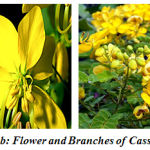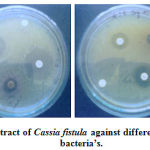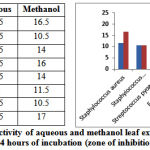Amit Kumar Dutta and Preeti Madharia
Department of Biotechnology, Rungta College of Science and Technology (Affiliated Pt. Ravishankar Shukla University, Raipur), Durg (India)
Abstract
Cassia fistula (Family - Leguminosae) is a deciduous and ornamental tree native to India and Sri Lanka. It is also known as golden shower, Indian laburnum, baton casse, keyok, klober etc. It is a fast growing tree of deciduous type and grows up to 9 m. The leaves of the tree are compound and have 4-8 pairs. Flowers of the tree are golden yellow in color and they hang in bunch which looks like a shower of up to 40 centi-meters. They are widely cultivated worldwide because of beauty. The flowers of the tree attract bees and butterflies.Cassia fistulaThere are various species of cassia worldwide which are used for medicinal purposes. Some species of the tree are used for their laxative properties. The study was carried out with an objective to investigate the antibacterial potentials of leaves of Cassia fistula. The aim of the study is to assess the antimicrobial activity and to determine the zone of inhibition of extracts on some bacterial strains. The antimicrobial activity was determined in the extracts using agar disc diffusion method. The antibacterial activities of extracts of Cassia fistula were tested against Gram-positive and Gram-negative pathogenic bacteria and different zone of inhibition was formed. The results showed that the remarkable inhibition of the bacterial growth was shown against the tested organisms. The microbial activity of the Cassia fistula was due to the presence of various secondary metabolites. Hence, these plants can be used to discover bioactive natural products that may serve as leads in the development of new pharmaceuticals research activities.
Keywords
Cassia fistula; Antibacterial activity; Gram Bacteria
Download this article as:| Copy the following to cite this article: Dutta A. K, Madharia P. In-vitro Evaluation of Antibacterial Activity of Cassia fistula against different Gram-positive and Gram-negative Bacteria. Biomed Pharmacol J 2012;5(1) |
| Copy the following to cite this URL: Dutta A. K, Madharia P. In-vitro Evaluation of Antibacterial Activity of Cassia fistula against different Gram-positive and Gram-negative Bacteria. Biomed Pharmacol J 2012;5(1). Available from: http://biomedpharmajournal.org/?p=2439 |
Introduction
The use of plants and plant products as medicines could be traced as far back as the beginning of human civilization. The earliest mention of medicinal use of plants in Hindu culture is founds in “Rig-Veda”, which is said to have been written between 4500-1600 B.C. and is supposed to be the oldest repository of human knowledge. It is Ayurveda, the foundation of medicinal science of Hindu culture, in its eight division deals with specific properties of drugs and various aspects of science of life and art of healing. The inhibition produced by the plant extracts against particular organisms depends upon various extrinsic and intrinsic parameters.1
 |
Figure 1 a and b: Flower and Branches of Cassia fistula |
Clinical microbiologists have a reason of interest in the topic of antimicrobial plant extracts. It is very likely that these phytochemical will find their way into the arsenal of antimicrobial drugs prescribed by physicians; several are already being tested in humans. It is reported that on an average, two or three antibiotics derived from microorganisms are launched each year.2
Cassia fistula plant have provided for the model of 50% of western drugs.3 Many commercially proven drugs used in modern medicine were initially used in crude from in traditional or folk healing practices, which suggests that it has potentially useful biological activities. The primary benefits of using plant derived medicines are that they are relatively safer than synthetic alternatives, offering profound therapeutic benefits and are more affordable.4 Antimicrobial activity studies: the antimicrobial activity of Cassia fistula was studied against Staphylococcus aureus, Bacillus subtilis and Escherichia coli.5
Objective
The main objective of our study was to Preliminary phytochemical analysis of dried leaf powder of plant Cassia fistula and to evaluate the antibacterial activity of extract from this plant against several Gram-positive and Gram-negative bacteria.
Materials and Methods
Plant species
Medicinal plant Cassia fistula was collected from Bhilai region of Chhattisgarh. Plant leaves were washed three times by running tap water and then with distilled water, dried and powdered for further use.
Test organisms
Microbial species
The reference species of bacteria were cultured in the routine basic media i.e., nutrient broth (Hi-media) and incubated at 37ºC for 24 hours, sub cultured regularly (every 30 days) and stored in nutrient agar slants at 4ºC as well as at -20ºC by making suspensions in 20% glycerol.
Results and Discussion
Preliminary phytochemical screening was carried out on plant extracts. It covered mainly tannins, alkaloids, saponins, cardiac glycosides, steroids, flavonoids and terpennoids estimation. The result of preliminary phytochemical analysis is: tannins, saponins, flavonoid, steroids and alkaloids are sparingly present.
Antibacterial activity
The plant which were taken, each of the four plants two different solvents were prepared namely, aqueous and methanol were tested against the eight bacteria’s i.e., Staphylococcus aureus, Staphylococcus epidermidis, streptococcus pyogenes, Escherichia coli, Pseudomonas aeruginosa, Proteus mirabilis, Proteus vulgaris and Enterobacter aeruginosa shown in figure no 2.
 |
Figure 2: Methanol and aqueous extract of Cassia fistula against different gram-positive and gram-negative bacteria’s.
|
According to above photographs, observation table and graph has been shown below
 |
Table and Graph 1: Antibacterial activity of aqueous and methanol leaf extract of cassia fistula at 25µl volume after 24 hours of incubation (zone of inhibition in mm) |
The crude extract of plants was selected for antimicrobial assay showed inhibitory effect on the several test organisms. The disc diffusion method was used to determine the antimicrobial activity of plant extract. The result revealed that the plant selected showed antibacterial activity with varying magnitude.
Conclusion
The results of present study suggests that some of the leaf extract possess compounds with antibacterial properties that can be used as antibacterial agents in new drugs for the therapy of skin and wound infections caused by pathogens. Extract of cassia fistula have the most potential antibacterial activity against all the bacteria strain thus tested. In general Gram-negative bacteria were found to be more susceptible than Gram-positive bacteria. Additional in vivo studies and clinical trials would be needed to justify and further evaluate the potential of these plant extract as potential antibacterial agents.
Acknowledgement
We are thankful to our Hon’ble Chairman Sir- Shri Sanjay Rungta for his help & support throughout the study. We owe our deep gratitude to Prof.(Dr) A. Jagadish- Group Director, Rungta Group of Colleges, Bhilai & Dr. G. D. Sao, Principal, Rungta College of Science & Technology, Durg & Prof.(Dr) A. Vani, Principal, GD Rungta College of Engineering & Technology, Bhilai for their time to time guidance throughout this project. We are really thankful to our Parents for their better cooperation throughout our career.
References
- Rastogi, R.P.; Mehrotra, B.N. Glossary of Indian Medicinal Plants. National Institute of Science Communication.
- Clark, A. M. Natural Products As A Resource For New Drugs. Res., 13:1996.
- Robbers J, Speedie M, Tyler V. Pharmacognosy and Pharmacobiotechnology, Willams Baltimore, 1-14:1996.
- Iwu M.W., Dunean A.R., Okunji C.O., New Antimicrobials of Plant Origin, In:Jjanick J. edition. Perspectives on New Crops and NEW Uses, Alexandria, V.A.: ASHS Press, 457-462: 1999.
- T, Vimalraj, Saravan.S, Nadivel.S and Thejomoorthy, Veterinary and Animal Science 5(3)109-113: 2009.







